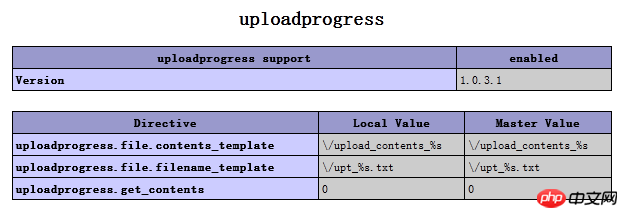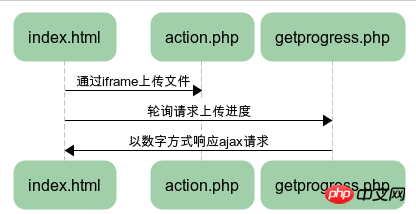 Backend Development
Backend Development
 PHP Tutorial
PHP Tutorial
 Detailed interpretation of php upload progress bar (recommended)
Detailed interpretation of php upload progress bar (recommended)
Detailed interpretation of php upload progress bar (recommended)
This article mainly introduces the detailed interpretation of the PHP upload progress bar (recommended). Interested friends can refer to it. I hope it will be helpful to everyone.
Three solutions for uploading files on the Web Share with everyone:

What I want to use here is the form method . By setting the enctype="multipart/form-data" attribute for the form element, the data submitted by the form is submitted in binary encoding, and the content of the uploaded file can be obtained by using the binary stream to obtain the content in the Servlet that receives this request. This enables file upload.
The enctype attribute of the form element specifies the encoding method of the form data. This attribute has 3 values:

I found two methods on the Internet, PHP cooperates with apc to implement it and uses uploadprogress to implement it. This time I want to use uploadprogress. Click the address to download the corresponding version of dll in php. Install the php_uploadprogress.dll extension and restart apache.

Principle of progress bar implementation:

An iframe method of uploading files without refreshing is used here.

The picture after the upload is completed:
<body>
<p style="padding:20px">
<form action="action.php" enctype="multipart/form-data" method="post" target="iframeUpload">
<iframe name="iframeUpload" width="400" height="400" frameborder='1'></iframe>
<input type="hidden" name="UPLOAD_IDENTIFIER" value="1" />
<input id="file1" name="file1" type="file"/>
<input value="上传" type="submit" onclick="startProgress()"/>
</form>
</p>
<p style="width: 500px; height: 20px;border:1px solid red">
<p style="position: relative; height: 20px; background-color: purple; width: 0%;" class="barinner"></p>
</p>
<p id='showNum'></p>
<p class="prbar">
<p class="prpos barinner"></p>
</p>
</body>In the above HTML code, please pay attention to UPLOAD_IDENTIFIER. This is used to locate and view which file is uploaded. Progressive. I will write it as a 1 here, but you can write it as a random number generated by PHP. The following is the JS script:
var proNum=0;
var loop=0;
var progressResult = "";
var interval;
function sendURL() {
$.ajax({
type : 'GET',
url : "getprogress.php",
async : true,
cache : false,
dataType : 'json',
data: "progress_key=" + $('input[name=UPLOAD_IDENTIFIER]').val(),
success : function(e) {
proNum=parseInt(e);
if(e){
$('.barinner').css('width', proNum+"%");
$('#showNum').html(proNum+"%");
setTimeout("getProgress()", 200);
}else{
if(interval == 1){
$('.barinner').css('width', "100%");
$('#showNum').html("100%");
}
}
}
});
}
function getProgress(){
loop++;
sendURL();
}
function startProgress(){
interval = 1;
$('.barinner').css('width', proNum+"%");
$('#showNum').html(proNum+"%");
setTimeout("getProgress()", 500);
}The following is the content of the getprogress.php file:
<?php
if (function_exists("uploadprogress_get_info")) {
$info = uploadprogress_get_info($_GET['progress_key']);
if(!empty($info)){
if(($info['bytes_uploaded'] < $info['bytes_total']) && !empty($info['bytes_uploaded']) && !empty($info['bytes_total'])){
$proNum = floor(($info['bytes_uploaded']/$info['bytes_total'])*100);
}else{
$proNum = 100;
}
echo $proNum;
}else{
echo 0;
}
}After the upload is completed, I show the CSS of two progress bars. The second one is using the latest Written in CSS3. Some CSS3 animation properties are used.

.prbar {
margin:5px;
width:500px;
background-color:#dddddd;
overflow:hidden;
/* 边框效果 */
border: 1px solid #bbbbbb;
-moz-border-radius: 15px;
border-radius: 15px;
/* 为进度条增加阴影效果 */
-webkit-box-shadow: 0px 2px 4px #555555;
-moz-box-shadow: 0px 2px 4px #555555;
box-shadow: 0px 2px 4px #555555;
}
/* No rounded corners for Opera, because the overflow:hidden dont work with rounded corners */
doesnotexist:-o-prefocus, .prbar {
border-radius:0px;
}
.prpos {
width:0%;
height:30px;
background-color:#3399ff;
border-right:1px solid #bbbbbb;
/* CSS3 进度条渐变 */
transition: width 2s ease;
-webkit-transition: width 0s ease;
-o-transition: width 0s ease;
-moz-transition: width 0s ease;
-ms-transition: width 0s ease;
/* CSS3 Stripes */
background-image: linear-gradient(135deg,#3399ff 25%,#99ccff 25%,#99ccff 50%, #3399ff 50%, #3399ff 75%,#99ccff 75%,#99ccff 100%);
background-image: -moz-linear-gradient(135deg,#3399ff 25%,#99ccff 25%,#99ccff 50%, #3399ff 50%, #3399ff 75%,#99ccff 75%,#99ccff 100%);
background-image: -ms-linear-gradient(135deg,#3399ff 25%,#99ccff 25%,#99ccff 50%, #3399ff 50%, #3399ff 75%,#99ccff 75%,#99ccff 100%);
background-image: -o-linear-gradient(135deg,#3399ff 25%,#99ccff 25%,#99ccff 50%, #3399ff 50%, #3399ff 75%,#99ccff 75%,#99ccff 100%);
background-image: -webkit-gradient(linear, 100% 100%, 0 0,color-stop(.25, #99ccff), color-stop(.25, #3399ff),color-stop(.5, #3399ff),color-stop(.5, #99ccff),color-stop(.75, #99ccff),color-stop(.75, #3399ff),color-stop(1, #3399ff));
background-image: -webkit-linear-gradient(135deg,#3399ff 25%,#99ccff 25%,#99ccff 50%, #3399ff 50%, #3399ff 75%,#99ccff 75%,#99ccff 100%);
background-size: 40px 40px;
/* Background stripes animation */
animation: bganim 3s linear 2s infinite;
-moz-animation: bganim 3s linear 2s infinite;
-webkit-animation: bganim 3s linear 2s infinite;
-o-animation: bganim 3s linear 2s infinite;
-ms-animation: bganim 3s linear 2s infinite;
}
@keyframes bganim {
from {background-position:0px;} to { background-position:40px;}
}
@-moz-keyframes bganim {
from {background-position:0px;} to { background-position:40px;}
}
@-webkit-keyframes bganim {
from {background-position:0px;} to { background-position:40px;}
}
@-o-keyframes bganim {
from {background-position:0px;} to { background-position:40px;}
}
@-ms-keyframes bganim {
from {background-position:0px;} to { background-position:40px;}
}Summary: The above is the entire content of this article, I hope it will be helpful to everyone's study.
Related recommendations:
php Detailed explanation of infinite classification tree data formatting code example
#SSO single sign-on system interface implemented by php Function example analysis
The above is the detailed content of Detailed interpretation of php upload progress bar (recommended). For more information, please follow other related articles on the PHP Chinese website!

Hot AI Tools

Undresser.AI Undress
AI-powered app for creating realistic nude photos

AI Clothes Remover
Online AI tool for removing clothes from photos.

Undress AI Tool
Undress images for free

Clothoff.io
AI clothes remover

Video Face Swap
Swap faces in any video effortlessly with our completely free AI face swap tool!

Hot Article

Hot Tools

Notepad++7.3.1
Easy-to-use and free code editor

SublimeText3 Chinese version
Chinese version, very easy to use

Zend Studio 13.0.1
Powerful PHP integrated development environment

Dreamweaver CS6
Visual web development tools

SublimeText3 Mac version
God-level code editing software (SublimeText3)

Hot Topics
 1664
1664
 14
14
 1423
1423
 52
52
 1317
1317
 25
25
 1268
1268
 29
29
 1244
1244
 24
24
 PHP and Python: Comparing Two Popular Programming Languages
Apr 14, 2025 am 12:13 AM
PHP and Python: Comparing Two Popular Programming Languages
Apr 14, 2025 am 12:13 AM
PHP and Python each have their own advantages, and choose according to project requirements. 1.PHP is suitable for web development, especially for rapid development and maintenance of websites. 2. Python is suitable for data science, machine learning and artificial intelligence, with concise syntax and suitable for beginners.
 PHP in Action: Real-World Examples and Applications
Apr 14, 2025 am 12:19 AM
PHP in Action: Real-World Examples and Applications
Apr 14, 2025 am 12:19 AM
PHP is widely used in e-commerce, content management systems and API development. 1) E-commerce: used for shopping cart function and payment processing. 2) Content management system: used for dynamic content generation and user management. 3) API development: used for RESTful API development and API security. Through performance optimization and best practices, the efficiency and maintainability of PHP applications are improved.
 Explain secure password hashing in PHP (e.g., password_hash, password_verify). Why not use MD5 or SHA1?
Apr 17, 2025 am 12:06 AM
Explain secure password hashing in PHP (e.g., password_hash, password_verify). Why not use MD5 or SHA1?
Apr 17, 2025 am 12:06 AM
In PHP, password_hash and password_verify functions should be used to implement secure password hashing, and MD5 or SHA1 should not be used. 1) password_hash generates a hash containing salt values to enhance security. 2) Password_verify verify password and ensure security by comparing hash values. 3) MD5 and SHA1 are vulnerable and lack salt values, and are not suitable for modern password security.
 PHP: A Key Language for Web Development
Apr 13, 2025 am 12:08 AM
PHP: A Key Language for Web Development
Apr 13, 2025 am 12:08 AM
PHP is a scripting language widely used on the server side, especially suitable for web development. 1.PHP can embed HTML, process HTTP requests and responses, and supports a variety of databases. 2.PHP is used to generate dynamic web content, process form data, access databases, etc., with strong community support and open source resources. 3. PHP is an interpreted language, and the execution process includes lexical analysis, grammatical analysis, compilation and execution. 4.PHP can be combined with MySQL for advanced applications such as user registration systems. 5. When debugging PHP, you can use functions such as error_reporting() and var_dump(). 6. Optimize PHP code to use caching mechanisms, optimize database queries and use built-in functions. 7
 How does PHP handle file uploads securely?
Apr 10, 2025 am 09:37 AM
How does PHP handle file uploads securely?
Apr 10, 2025 am 09:37 AM
PHP handles file uploads through the $\_FILES variable. The methods to ensure security include: 1. Check upload errors, 2. Verify file type and size, 3. Prevent file overwriting, 4. Move files to a permanent storage location.
 How does PHP type hinting work, including scalar types, return types, union types, and nullable types?
Apr 17, 2025 am 12:25 AM
How does PHP type hinting work, including scalar types, return types, union types, and nullable types?
Apr 17, 2025 am 12:25 AM
PHP type prompts to improve code quality and readability. 1) Scalar type tips: Since PHP7.0, basic data types are allowed to be specified in function parameters, such as int, float, etc. 2) Return type prompt: Ensure the consistency of the function return value type. 3) Union type prompt: Since PHP8.0, multiple types are allowed to be specified in function parameters or return values. 4) Nullable type prompt: Allows to include null values and handle functions that may return null values.
 The Enduring Relevance of PHP: Is It Still Alive?
Apr 14, 2025 am 12:12 AM
The Enduring Relevance of PHP: Is It Still Alive?
Apr 14, 2025 am 12:12 AM
PHP is still dynamic and still occupies an important position in the field of modern programming. 1) PHP's simplicity and powerful community support make it widely used in web development; 2) Its flexibility and stability make it outstanding in handling web forms, database operations and file processing; 3) PHP is constantly evolving and optimizing, suitable for beginners and experienced developers.
 PHP vs. Python: Understanding the Differences
Apr 11, 2025 am 12:15 AM
PHP vs. Python: Understanding the Differences
Apr 11, 2025 am 12:15 AM
PHP and Python each have their own advantages, and the choice should be based on project requirements. 1.PHP is suitable for web development, with simple syntax and high execution efficiency. 2. Python is suitable for data science and machine learning, with concise syntax and rich libraries.



